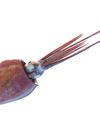
At present, there are more than 44,000 species around the world that are facing the possibility of extinction. Keeping a watchful eye over them is the International Union for Conservation of Nature (IUCN), composed of governments and civil society organisations. Since 1964, the IUCN has compiled the Red List of Threatened Species, a comprehensive guide to the state of nature and the likelihood of plant and animal extinction. From ‘least concern’ to ‘extinct’, each species that’s assessed by the IUCN is placed on the scale to indicate their conservation status.
For example, to be categorised as ‘critically endangered’ a species needs to meet specific conditions, such as fewer than 250 mature individuals, a population reduction of 70 per cent or more in the past ten years or a population that continues to decline by 25 per cent or more over three years. This informative tool not only lists species’ status in the world, but also acts as a reference for many different agencies and organisations to enact policy changes and protections in the hopes of protecting wildlife.
The IUCN list is filled with 157,100 species, of which 28 per cent are ‘threatened with extinction’. The IUCN aims to assess a further 160,000 species and transform the IUCN Red List into a ‘barometer of life’. Here are just some of the many critically endangered animals that are facing extinction.
DUSKY GOPHER FROG (RANA SEVOSA)
Diese Geschichte stammt aus der Issue 190-Ausgabe von How It Works UK.
Starten Sie Ihre 7-tägige kostenlose Testversion von Magzter GOLD, um auf Tausende kuratierte Premium-Storys sowie über 8.000 Zeitschriften und Zeitungen zuzugreifen.
Bereits Abonnent ? Anmelden
Diese Geschichte stammt aus der Issue 190-Ausgabe von How It Works UK.
Starten Sie Ihre 7-tägige kostenlose Testversion von Magzter GOLD, um auf Tausende kuratierte Premium-Storys sowie über 8.000 Zeitschriften und Zeitungen zuzugreifen.
Bereits Abonnent? Anmelden

INCREDIBLE SOLAR SYSTEM CRATERS
Why these spectacular craters carved out by past impact events are among the most widespread and distinctive geological features in the Solar System

HOW NORTH AMERICA'S GREAT LAKES FORMED
The world's largest freshwater system comprises five immense interconnected lakes, carved into Earth by glaciers

BUILDING THE WORLD'S DEEPEST CAR PARK
Australia's most famous landmark is often marvelled at from ground level, but its innovative spiral substructure is a hidden gem

FINDING THE COLOSSAL SQUID
This elusive creature spawned a legend of a deep-sea monster that endured for centuries

Octopuses burn more calories changing colour than you do on a 23 minute run
For octopuses, changing colour burns about as many calories as a human on a 23-minute run. Octopuses are masters of disguise, changing colour at the drop of a hat to startle predators and hide from prey.
The world's first silicon-anode battery could revolutionise electronic vehicles
A ceramic battery manufacturer has unveiled a solid-state battery concept that can be charged from 5 to 60 per cent capacity in just five minutes, giving future electric vehicles (EVS) a 186-mile range in the time it takes to order a coffee.

New technology gives AI the power to feel surfaces
Scientists have given artificial intelligence (AI) the capacity to 'feel' surfaces for the first time, opening up a new dimension for deploying the technology in the real world.

Visit Plane Earth 2125
How might our world have transformed under the strain of climate change 100 years from now?

The world's largest organism may have been growing for 80,000 years
Pando, an enormous quaking aspen that spans more than 40 hectares in Utah, is not only one of the largest known organisms on Earth, it's also one of the oldest.

Scientists detect the most powerful cosmic rays ever
Scientists have detected the most energetic cosmic rays ever discovered, and they're being produced by mysterious sources relatively close to Earth.